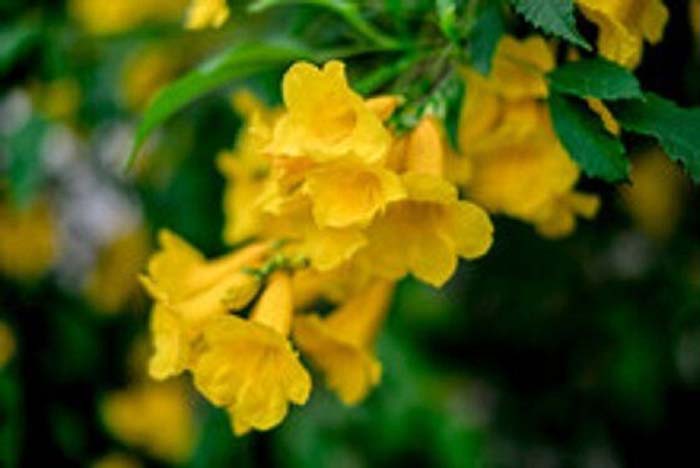Yarden August 2023
Published 3:44 pm Thursday, August 3, 2023

- MELLOW YELLOW: Yellow bells or esperanza are relatively low maintenance and grow best in the full sun, even when it’s scorching.
Sponsored by Thomasville Garden Club
NATIONAL RAIN DAY – July 29, 2023
Trending
Last month, I asked you to remember to see if we received rain on Saturday, July 29. Did you take notice? In my neighborhood and elsewhere around Thomas County (and beyond), rain did, indeed, fall. That morning, a weather warning was sent to my phone predicting heavy storms with potentially damaging winds. Fortunately, we did not receive the latter, but we did receive a couple of hours of steady rain.
AUGUST WEATHER
So far, the summer of 2023 in the Northern Hemisphere is experiencing “soaring temperature records” – and they are expected to continue. Not only are the temperatures breaking records but records are being broken for the number of days the highs continue. Europe and Asia have been experiencing record-breaking temperatures, also. In addition, the World Meteorological Organization confirmed record high temperatures at sea as well as on land.
Recently, I learned about something called “wet bulb temperature.” (EarthSky, July 20, 2023) Wet bulb temperature is a way to express the effect of temperature and humidity combined and how they relate to the amount of both that the human body can bear. Remember, we cool by sweating, but if the temperature is too high in relation to the humidity, we cannot endure being outside. Exposure to a wet bulb temperature that is too great over too long a time could cause heat stroke or even death because our body cannot adequately regulate itself in such a circumstance. Recent research has shown that a wet bulb temperature of 87⁰ F and 100% humidity is the maximum that even young, healthy subjects can endure. The article said that we are dangerously close to the wet bulb temperature threshold and that, in some places, it has already been reached for short periods.
Here, in SW Georgia, we can expect “oppressive, showery, thundery” conditions for the rest of the summer of 2023. Our normal high and low temperatures in August are 92⁰ and 71⁰, with an average of 8 days of rain.
We are in the “dog days of summer,” the hottest and most humid days of summer. They extend until August 11. They are named for the brightest star in the sky, Sirius (the Dog Star), which is in the constellation of Canis Major, the “Greater Dog.” Sirius is an ancient Greek word that means glowing or burning.
Trending
“Hurricane season” usually peaks between mid-August and late October.
GARDENING FOR WILDLIFE
The number of people who are gardening with the specific purpose of improving wildlife is growing, according to a survey by the National Garden Association. At least 35% of gardeners are growing plants that are beneficial to bees, butterflies and birds. Almost as many are also intentionally growing native plants. These gardeners are not relying upon conservation associations to provide biodiversity and create a better world environment. The cumulative efforts of wildlife gardeners can make an important impact upon the entire planet.
7 PLANTS THAT CAN STAND A SCORCHING SUMMER
Last month’s newsletter from the National Gardening Association listed 7 plants that will continue to grace your “sizzling” yarden with summer beauty.
1) Plumbago is prized as one of the few plants that produce blue flowers. It has proved to be tough enough to survive for more than a month without rain or irrigation during the heat of summer. Not that it looks in tip-top shape at the end of that period, but given some of either, it will recover, resume growing, and bloom again quite quickly.
2) The red bird of paradise or ‘Pride of Barbados’ (Caesalpinia pulcherrima) is an orange-yellow flowered tender perennial accent in the yarden. Its eye-catching blooms rise above a 4-5 foot tall bed of foliage. Do not over-water it; it needs very little supplemental irrigation.
3) Yellow bells or esperanza is an evergreen shrub with bright yellow tubular flowers that bloom from spring to fall. It grows best in full sun, even in South Georgia! Too much shade reduces blooming. It is a low-maintenance plant with excellent drought tolerance, requiring water only when the soil dries. The article said esperanza is “among the most dependable choices for summer blooms.”
4) Rose mallow or hardy hibiscus (Hibiscus moscheutos) “commands attention with dinner plate-sized blooms in red, pink, white, and white with a pink blush.” The plants may grow from 2 to 5 feet tall, or more. They require full sun and good drainage in “dependable” soil moisture.
5) Cigar plant has red-orange, narrow, tubular flowers that are a little over an inch long. This plant is a tender perennial in our region. It grows about 3 feet tall and likes full sun and dependable soil moisture. It attracts hummers and butterflies.
6) Firebush (Hamelia patens) is very heat tolerant but not drought tolerant; it requires regular irrigation. It is a soft-stemmed, evergreen shrub that thrives in full sun. Its orange-red blossoms are narrow, tubular and 1-1½ inch long and attract pollinators. Its foliage becomes reddish when the temperature cools in the fall.
7) Thryallis (Galphimia glauca) is unfamiliar to me but it is one of the favorite landscape plants of the author of the article I am citing. It is a shrub that grows from 5-6 feet tall and prefers full sun and good drainage. Once established, it is drought-resistant. When in full bloom, it is covered with yellow bloom clusters. Blooms begin in summer and continue through fall.
DROUGHT- RESISTANT PLANTS
Another issue of last month’s National Gardening Association’s newsletter addressed plants that require minimal rainfall or irrigation. Three types of plants were discussed.
Midwestern Prairie Plants
These plants have become popular because they are able to thrive in full sun. They have “significant” root systems that tap into water that lies far below the surface of the soil. Silphium – compass plants, prairie dock and cup plants, members of the aster family – have “architectural foliage and stature,” meaning that they possess three-dimensional organization in their branching pattern and the size, shape and position of their leaves and flowers. These features help to make them drought tolerant.. Coneflowers (echinacea) are very well-known. They are related to silphiums and they flourish in almost any soil that has sufficient drainage.
Ornamental Grasses
Many of these grasses are native plants, and many hail from the prairies. Two examples are prairie dropseed and switch grasses.
I decided to investigate some other drought-tolerant ornamental grasses. I found 2 that sound especially good to me: resistant not only to drought but to deer, pollution and many other pests; pollinator-friendly; attractive to the eye; easy to maintain; non-invasive. They are both familiar.
1) Big bluestem has a root system that can be up to 10 feet deep. It is very desirable as an erosion stopper as well as a pollinator attracter. It prefers full sun to partial shade and well-draining sandy soil or clay.
2) Fountain grass adds movement and seasonal color to the yarden. The flower spikes are like bottlebrushes. It prefers full sun (it will not bloom well in shade) and well-drained sandy, loamy soil or clay.
Xeriscaping
Xeriscaping is a method of growing drought-tolerant plants in basically dry gardens containing gravel, sand, silt or clay or a combination of such soils. Cacti – and they are numerous – are the best-known plants for xeriscapes. The prickly pear is a great example and it thrives in practically every state East of the Mississippi River.
Agave, a succulent, not a cactus, is another excellent choice for xeriscapes. There are numerous varieties of agave, also. The Adams needle was the example given in the article because of its dramatic flowering stalks that can extend up to 10 feet tall and contain creamy-white, pendant, bell-shaped blossoms.
(The Birds&Blooms website has a good article called “Top 15 Drought-Tolerant Plants That Can Handle Dry Weather.” and then it goes on to list 34 more!)
SCORCHING SUMMER PLANT CARE
Information from the Victory Seed Company
Water. Obviously, plants need more frequent irrigation during scorching weather like we are having this summer. Watering plants in the morning is always a good idea but it is especially true now in order to permit the water enough time to soak into the soil before the blistering heat can cause too much evaporation. Drip hoses are best for deeply watering the roots of plants, not just the leaves. Of course, if plants wilt in the afternoon, apply additional, light, watering. However, we are warned not to soak the foliage.
Is that because water on foliage is harmful? The answer is – there is contention regarding this claim and the conclusion is unclear. The author of the article suspects that droplets of water on foliage do no harm but, on the other hand, those drops of water are doing no good, either. Water on soil soaks in and is not wasted; overhead watering is.
Mulch. Add 2 to 3 inches of mulch to help retain moisture in the soil.
Shade. Providing shade by using trellises, pergolas, temporary shade structures, or even umbrellas is helpful for vulnerable plants. The author uses 40% shade cloths which “provide plenty of cooling but still permit quite a bit of light to come through.” Potted plants can be moved to shadier locations.
Pruning. We need not hesitate to prune plants that have become leggy. Trimming excessive summer growth permits plants to produce new growth that will be better equipped to adapt to the heat.
Not only that, the plants will look better and will be healthier. The author mentioned that he rigorously trims tomato plants at this time of year. Heavy pruning of other plants is not recommended, however.
Replanting. In the vegetable garden, lettuces, spinach, kale and other leafy plants bolt and summer squash, cucumbers and beans start to fail in excessive heat. All of these quick-growing plants can easily be dug up and replanted for a second harvest.
Heat-hardy vegetables. The most obvious method of having plants that survive the heat is to choose varieties that naturally do just that! Some such vegetables are peppers, eggplants, okra, cucumbers and melons. There are several varieties of tomatoes that succeed in the heat, also. Gardeners must choose plants that are meant to withstand summer’s heat.
And, last: have patience. Plant growth might slow down greatly in the scorching heat but continue to supply ample water, provide shade, if necessary, and trim back plants that are stressed. Doing so should provide most plants enough help that they will survive. Then, when temperatures start to lessen again, they should renew their vigor.
Pat Pankey writes this column for Thomasville Garden Club, Inc. as a service to the community.Thomasville Garden Club, Inc. welcomes new members. If you are interested, please contact Membership Chair Vicky Johnson at 224-0590 or any current member.





